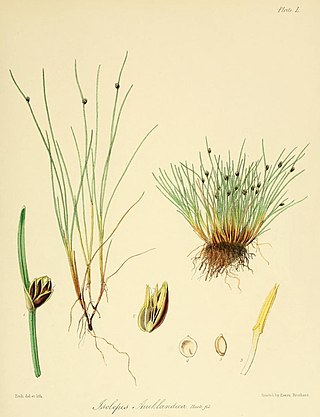
Phytophthora is a genus of plant-damaging oomycetes, whose member species are capable of causing enormous economic losses on crops worldwide, as well as environmental damage in natural ecosystems. The cell wall of Phytophthora is made up of cellulose. The genus was first described by Heinrich Anton de Bary in 1875. Approximately 210 species have been described, although 100–500 undiscovered Phytophthora species are estimated to exist.

Scirpus is a genus of grass-like species in the sedge family Cyperaceae many with the common names club-rush, wood club-rush or bulrush. They mostly inhabit wetlands and damp locations.
Assemblages of plants and invertebrate animals of tumulus springs of the Swan Coastal Plain are ecological communities in Western Australia. They have been managed under a number of other, similar names, including Mound springs of the Swan Coastal Plain and Communities of Tumulus Springs . The tumulus mounds were common to a narrow range of groundwater discharge at the boundary of 'bassendean sand' and 'guildford clay', along the edge of the Gnangara Mound aquifer. The communities are critically endangered.

Albizia inundata is a perennial tree native to South America. Common names include maloxo, muqum, paloflojo, timbo blanco, timbo-ata, and also "canafistula" though this usually refers Cassia fistula.

Taxandria is a group of plants in the family Myrtaceae described as a genus in 2007. The entire genus is endemic to Western Australia, growing near the coast in the South West corner of the State.

Lycopodiella inundata is a species of club moss known by the common names inundated club moss, marsh clubmoss and northern bog club moss. It has a circumpolar and circumboreal distribution, occurring throughout the northern Northern Hemisphere from the Arctic to montane temperate regions in Eurasia and North America. It grows in wet habitat, such as bogs, ponds, moist spots on the tundra, and long-standing borrow pits.

Isolepis cernua is a species of flowering plant in the sedge family known by the common names low bulrush, slender club-rush, tufted clubrush, and fiberoptic grass. It is widespread, being native to many regions of the world, including parts of Australasia, Eurasia, Africa, and North and South America.

Isolepis setacea is a species of flowering plant in the sedge family known by the common names bristle club-rush and bristleleaf bulrush. It is native to Eurasia and Africa, and possibly Australasia. It can be found in other places, including some areas in North America, where it is an introduced species. It grows in many types of moist and wet habitat, often in coastal regions, and sometimes inland. It is a perennial herb which forms mats of very thin, grooved, erect or arching stems up to about 20 centimeters tall. The leaves sheath the stem bases and have short, flat, thick blades. The inflorescence is a solitary spikelet just a few millimeters long, or a cluster of up to three spikelets. These are accompanied by a stiff bract extending past the flowers.
Victoria, Australia contains approximately 32,000 hectares of temperate rainforest in various regions, which represents 0.14% of the State's total area. The areas with rainforest include: East Gippsland, Strzelecki Ranges, Wilsons Promontory, Central Highlands, and Otway Ranges. The rainforests vary between cool temperate, warm temperate, and mixed cool temperate.

Isolepis is a cosmopolitan genus of sedge containing around 70 species. Isolepis is found in cool tropical and temperate climates often in Africa and Australasia.

Isolepis fluitans, the floating scirpus, is a species of flowering plant in the sedge family. It is native to Africa, Australasia, Europe, and the Pacific islands. It was first described by Carl Linnaeus in 1753, and later transferred to Isolepis by the botanist Robert Brown in 1810.

Isolepis prolifera is a species of flowering plant in the family Cyperaceae that grows in temperate regions of the Southern Hemisphere. It has leafless stems up to 90 cm (35 in) tall, and clusters of flowers that often proliferate into branches.
David Lloyd Jones is an Australian horticultural botanist and the author of many books and papers, especially on Australian orchids.

Isolepis aucklandica is a species of flowering plant in the Cyperaceae family. It is native to New Zealand, Australia, Argentina, Peru, Colombia, Ecuador, Macquarie Island, the French Southern Territories of Saint Paul and Amsterdam Islands, and New Guinea.
Goodenia inundata is a species of flowering plant in the family Goodeniaceae and is endemic to the Kimberley region of Western Australia. It is an erect, annual or ephemeral herb with narrow egg-shaped stem-leaves and panicles of purple or maroon flowers with a yellow centre.
Bossiaea inundata is a species of flowering plant in the family Fabaceae and is endemic to the Murchison River Gorge in Western Australia. It is a spreading, openly-branched shrub with oblong, elliptic or egg-shaped leaves with the narrower end towards the base, and deep yellow and red flowers.

Isolepis congrua, the slender club-sedge, is a species of flowering plant in the sedge family. A small, tufted annual plant growing to 20 cm tall, often seen in the Australian Outback.

Isolepis habra is a species of flowering plant in the sedge family. A small, tufted perennial plant growing to 30 cm tall, seen in south eastern Australia and New Zealand.

Isolepis producta is a species of flowering plant in the sedge family. A small aquatic plant seen in southern Australia. The habitat is lagoons, lakes and streams.













